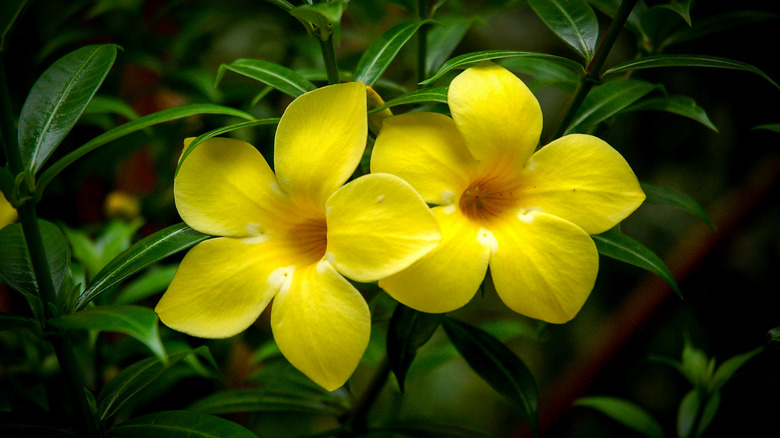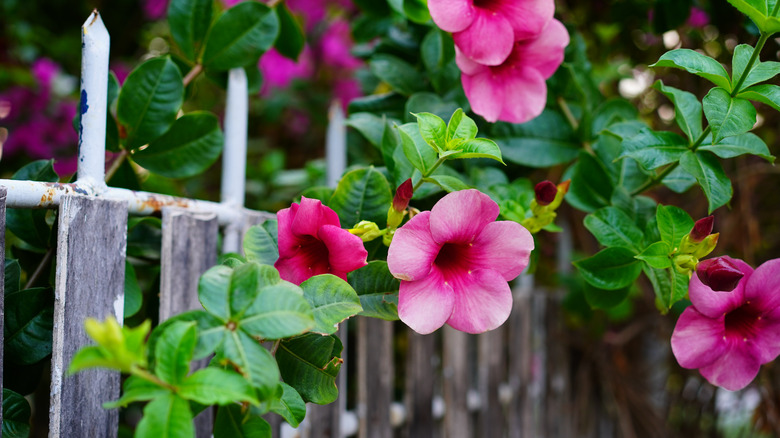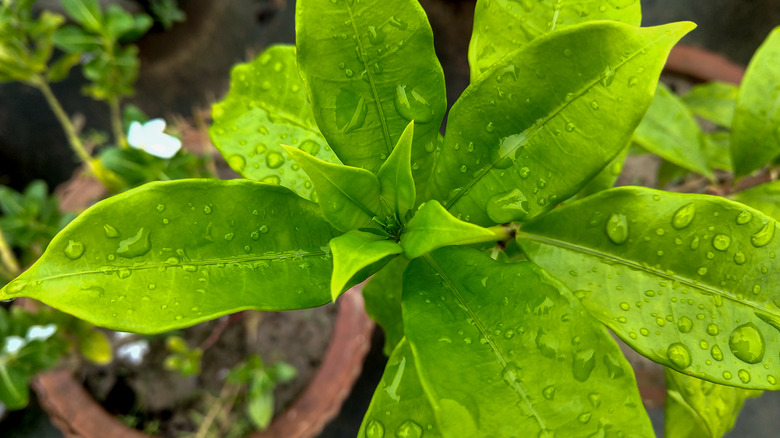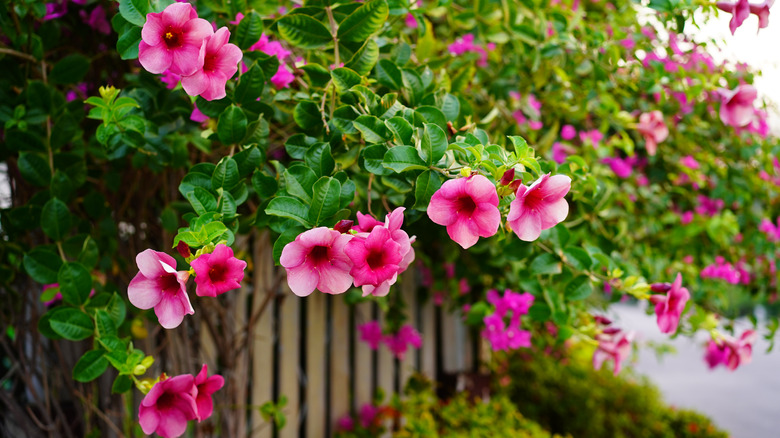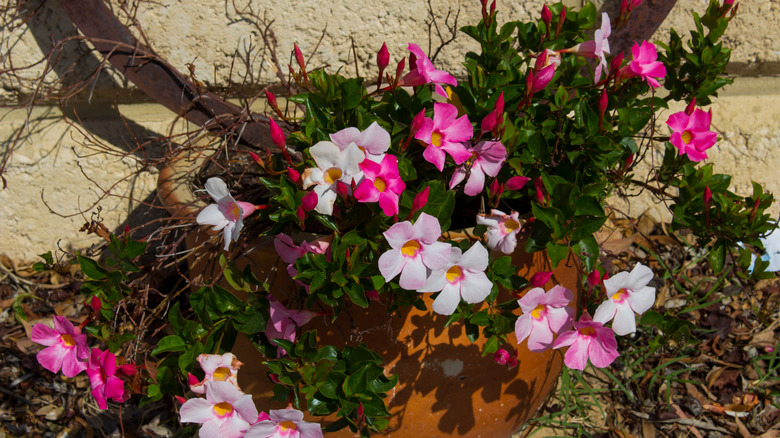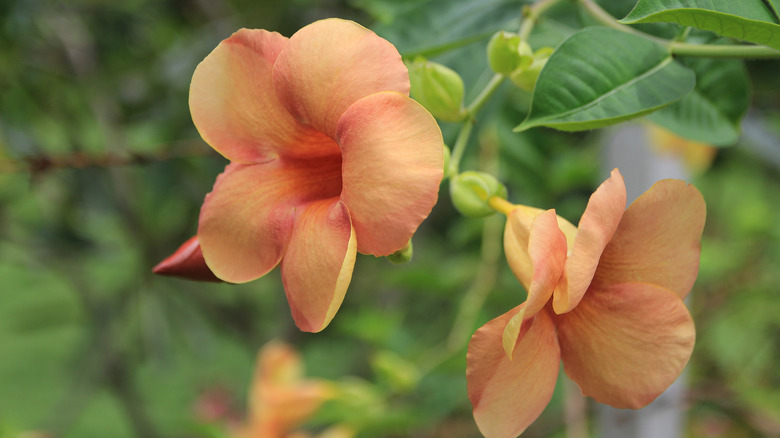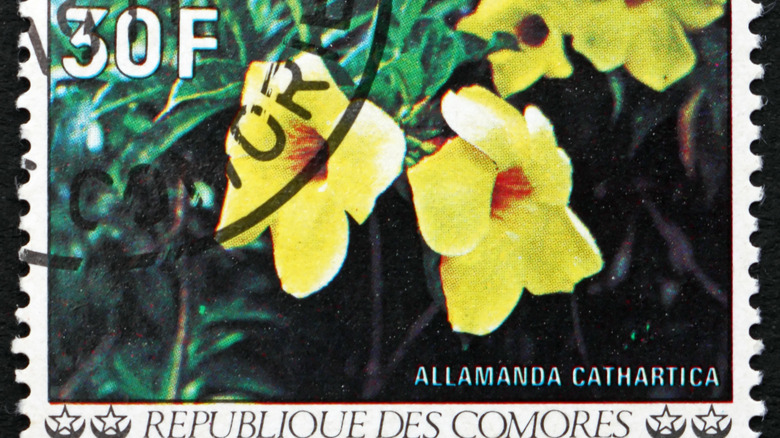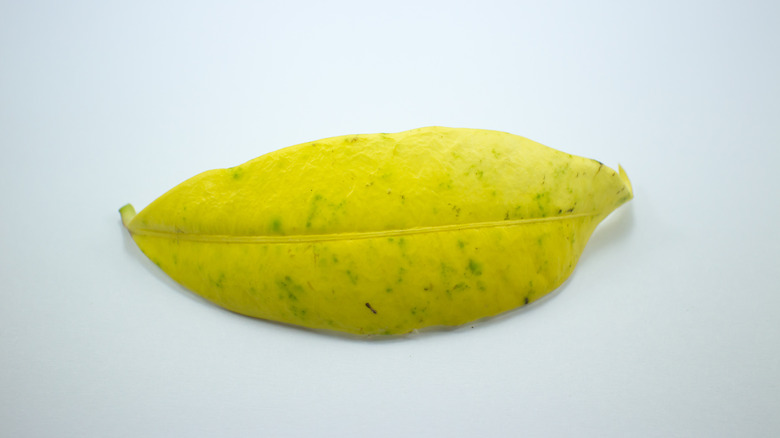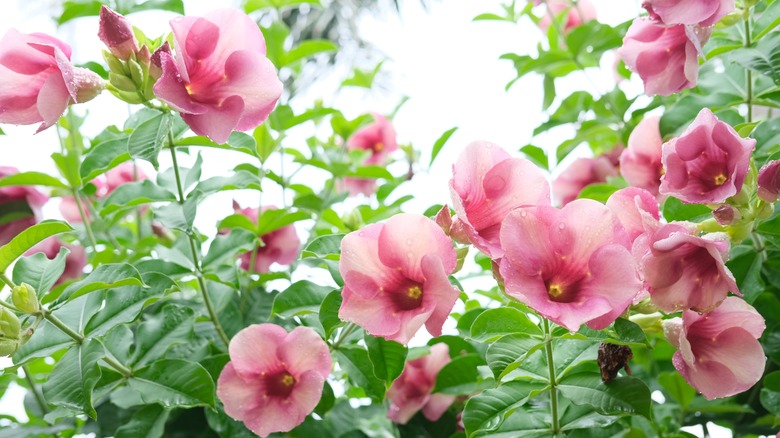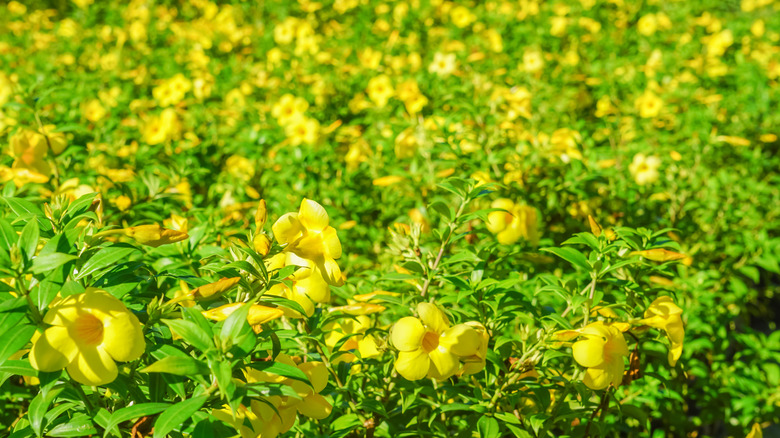How To Grow And Care For A Flowering Allamanda Vine
Most often referred to as the golden trumpet, Allamanda cathartica is a flowering vine native to Central and South America. It was first described and classified by the great Carl Linnaeus, considered one of the most influential and important botanists in history, as per the University of California, Berkeley. He named this robust flower after Dr. Frédéric-Louis Allamand, a fellow botanist and friend from Switzerland. Bright yellow is the most common color for allamanda flowers, hence the golden nickname, but you can also find the blooms in gorgeous shades of pink and peach.
Kew Royal Botanical Gardens describes the leaves of the allamanda as lance-shaped, meaning they taper from base to tip. Individual leaves tend to grow a few inches long and about 1 inch wide. That size pales compared to the glorious trumpet-shaped blossoms, which can be close to 4 inches long and over 2 inches wide. Each vine of this often mammoth-sized plant has the potential to stretch well over 20 feet high.
Fifteen Allamanda species have been classified so far; the latest discovery occurred in 2009. Even though this happened in Brazil, where the plant is commonly found, research shows that the original introduction of the golden trumpet vine made its way to South America from Africa as many as 20 million years ago. These days, allamandas have spread across the globe and naturalized themselves into many tropical locations, including the rainforests of Queensland, Australia. They are popular in USDA hardiness zones 10 and higher within the United States, where you can find them gracing many a landscape in places like South Florida and much of California.
How to use a flowering allamanda vine in the garden
Because a flowering allamanda vine can become quite large (over 20 feet long), making the best use of it in a landscape or garden setting requires a bit of advance planning. Some vine species send out twining tendrils which allow them to secure themselves to the ground or trunks of other trees. Per South Florida Plant Guide, the allamanda vine has no such method of attachment and, therefore, needs a little guidance as it continues to grow. Luckily, it's relatively obedient and will take direction well. Secure your allamanda along a fence, use it to adorn the length of a deck railing, or train it to grow up and over an arbor or trellis. Whichever way you choose to go with your plant, a support structure will be important for this one unless you plan to keep it trimmed back in shrub form.
If, on the other hand, you balk at the mere suggestion of telling your plants what to do or where to grow, you could opt to let them do their own thing. Left to its own devices, this wild child will ramble loosely, cottage garden style. The most important factor to keep in mind is that allamanda vines require full sun to produce an abundance of blooms. When planting, give each vine room to grow by keeping other plants at least 3 feet away. Expect shrubs to become bushy and spread to around 5 feet wide.
How to grow a flowering allamanda vine
Generally speaking, there are a few different ways to propagate your average plant. Some grow best from seed, while others need a more complicated process like grafting. Allamanda vines sit right in the sweet spot between the two and do really well when propagated by cuttings rooted in soil. Gardening with Johnson Engleng uses his YouTube channel to show us the best way to go about this method. The first step is to cut a healthy piece of stem from a mature plant. It's about 1 foot long. With clean, sharp cutting shears, he removes the leaves and snips the stem in half with a quick cut at a 45-degree angle. Applying rooting hormone to each cut is recommended to foster root growth and reduce fungus.
What's interesting here is that Engleng uses aloe vera gel instead of a commercial rooting hormone. This is a common practice among organic growers. In a study performed by the University of Jaffna in Sri Lanka, aloe vera gel was, in fact, shown to increase the length, strength, and overall quantity of roots. An important note from the study is that aloe vera worked for semi-hardwood cuttings but not softwood. If you want to try the natural and environmentally-friendly aloe vera option, take your cuttings from a thicker, woodier part of the vine instead of newer, greener growth. You could also opt for the standard liquid or powder rooting hormones found in garden centers.
For soil, Engleng mixes cocoa peat and standard potting soil. Poke two holes a few inches apart with your finger and gently place the cuttings down into them, taking care not to wipe away the hormone. Give them some water and place your grow pot in an area that will receive bright yet indirect light. (They'll get plenty of direct sunlight later after they've rooted and are sprouting leaves.) You should see growth in about six weeks or so.
How to care for a flowering allamanda vine
Once you've got your plants good and growing — and you've decided how and where you want to use them in your landscape — it's time to get them into the ground and give them their best chance at success. Your climate zone will decide whether they will grow year-round (USDA hardiness zone 10 and higher) or make beautiful summer annuals that you can either overwinter inside a greenhouse or simply let go at the end of the season.
According to the University of Wisconsin-Madison's Horticulture Division, growing allamanda plants need both moist and well-draining soil and full sun exposure, as you already know. Be sure to plant them in a spot that will receive a minimum daily allotment of four hours of direct sun; the more sunlight, the better when it comes to flower production. Dig a hole bigger than the grow pot and line it with a layer of nutrient-rich garden soil. Gently tip your plant over and tap the bottom of the pot to release the entire root ball. Move carefully to keep everything intact as you place the plant in its new home. Backfill with more garden soil and tamp down just a touch to make sure you've covered it with enough dirt to secure it into place.
Water your vines regularly through the summer months, never letting the soil completely dry out. Provided the soil is truly well-draining, you should not have any problems with standing water. Remember to give your vines structural support and opportunities for attachment as they grow.
Container growing and repotting allamanda vines
Just because this is a large plant doesn't mean it can't be a happy container or houseplant. Per Gardening Know How, so long as you've got a window with the right amount of exposure, you can grow a healthy flowering vine indoors. One of the benefits of growing allamanda in a container is that it will be easier to maintain at a smaller size. You'll just need to stay on top of a pruning schedule to keep it to scale.
Think "tropical" and "greenhouse" when setting up space inside your home for your colorful guests. Supplemental full spectrum lighting and a humidifier will come in handy for anyone attempting to grow indoor tropical plants in a northern climate zone. When it comes time to pot, an even mix of peat, compost, and sand will make it feel right at home. Never forget the drainage holes!
Regardless of how far back you intend to prune it, your vine will still need some sort of support. Indoors, you can use simple stakes or small bamboo tripods. Ohio Tropics offers up a seven-step tutorial for making your own moss pole. It's a pretty simple DIY project that can benefit your allamanda vine tremendously by mimicking the conditions it would otherwise find in the natural world.
If your golden trumpet outgrows its container, you'll need to consider repotting it into something larger. When choosing a new container, only go up a few inches in diameter. Anything bigger can make it difficult for roots to pull water from the surrounding soil. All plants will acclimate to whatever soil they're given, so it is advisable to use a fresh mix of exactly the same kind of soil it's already growing in. To further reduce the incidence of transplant shock, work quickly so those fragile root systems are not exposed to any elements or temperature changes for long.
Flowering allamanda vine varieties
Bright yellow flowers adorn the standard Allamanda cathartica vine. Per VerdeGo Landscaping, among these golden trumpets, there are at least four plant varieties, each with a slightly different shape. Allamanda brown bud has an orange button at the center of its yellow flowers. The allamanda bush will maintain a shrub-like form with a maximum height and width of 6 feet and 4 feet, respectively. Dwarf Allamanda (Allamanda cathartica 'compacta') stays smaller still, maxing out at 3 feet high and 3 feet wide. These can be used as border plants or to create a low-lying hedge. Lastly, the golden butterfly will give you the most aggressive climbing capabilities of them all.
Apart from the golden trumpets, there are other beautiful creations to consider for your garden.
- Peaches and Cream (Allamanda Peach mianaus) offers stunning two-toned flower petals that radiate from a dark center and fluctuate between warm oranges and pale cream tones.
- Allamanda Blanca (Allamanda alba) gives you a rare opportunity to own a white flowering allamanda. This one is also called the white trumpet.
- Purple Allamanda (Allamanda blanchetii) is not exactly purple despite its common name. Instead, it can be found in various shades of pale and bright pinks, rosy blush tones, and violets.
- Cherry Allamanda (Allamanda 'Cherries Jubilee') is another two-toned variety. The flower petals of this stunner vacillate between pale pink and a near-fuchsia hue.
- Mini Red Cabernet Allamanda (Allamanda x violacea Cabernet) is the way to go if you like a true red, almost burgundy-toned flower. Botanists brought together the bush and vining varieties to create this mini hybrid, which is notated by the x in its name. Unlike many of the others, the mini red cabernet can be easily maintained in a container. Golden trumpet lovers will love this type because it can be given as a gift that will not overwhelm its receiver as the others may.
Are allamanda vines toxic?
North Carolina Extension Gardener Plant Toolbox confirms that all parts of the Allamanda cathartica plant are, unfortunately, poisonous to humans and pets. In small quantities, the severity of toxicity is considered low, but these plants do have the potential to cause serious issues when consumed in large doses. We've all heard stories of a cat or dog who just couldn't help themselves from overindulging in the crunchy foliage of a houseplant, so caution is advised. Skin irritation, or dermatitis, will likely be the first mild sign of reaction. From there, a person or pet may experience gastrointestinal distress such as nausea, indigestion, and diarrhea. Fever and swollen lips are other possible symptoms. If there is ever cause for concern, seek the help of medical professionals or call a poison hotline immediately.
Contrarily, this plant also offers some medicinal uses when used in very low and controlled doses. According to the National Parks Flora & Fauna Web of Singapore, some of the same symptoms that result from mild poisoning can be sought after in different situations. As such, this plant has been used in traditional folk medicine as a natural laxative and to induce vomiting when medically necessary. Because of its potential to become a serious toxic threat, amateur experimentation with ingesting allamanda is not advised.
Common pests and diseases with allamanda vines
Though pest free for the most part, Gardenia still advises you to be on the lookout for scale and mealy bugs when you've got flowering allamanda vines gracing your garden. The insects are true pests indeed, and can be challenging to keep in check. University of Florida's Institute of Food and Agricultural Sciences (IFAS) breaks down pest control for these types of invaders with a multi-pronged approach. For prevention, look out for bugs on store-bought plants, so you know exactly what you're bringing home before it even gets there. Regarding sanitation, dispose of any plants suffering from an extreme infestation. Be sure to discard infested soil as well. Place everything in a garbage bag, tie it tight, and get it far away from the garden ASAP.
IFAS further advises introducing beneficial insects that will take care of your problem naturally. There is actually a beetle nicknamed the mealybug destroyer. Parasitic wasps, lacewings, and scale-eating caterpillars may help as well. Of course, we get it if adding to the insect population is not the way you want to go. In that case, try insecticidal soaps and high-pressure water sprays before resorting to harsh chemical pesticides.
Spotted or dropping leaves generally signal issues with watering. Keep the soil moist without overwatering or allowing the plant to become water-logged. Yellowing leaves could be trying to tell you they're suffering from nutrient-deficient soil.
Best fertilization practices for allamanda vines
When considering what kind of fertilizer application is best for your allamandas, first consider the age of your plants. If you live in a cooler USDA hardiness zone, you're likely working with a young plant that will only be kept for the season as an annual. On the other hand, perhaps you live in a warm zone, and your allamanda is a year-round staple in your garden.
Per Backyard Gardener, juvenile plants will benefit from phosphorous, which helps them to develop strong roots. For older plants, a general all-purpose fertilizer will usually work. If it doesn't seem to be helping, you can do a soil test to figure out if any particular nutrients are missing from your yard and go from there. Nitrogen is often the culprit but be careful when supplementing with it. Too much nitrogen will force foliage growth while curbing the progress of buds and flowers, leaving you with a bushy pile of nothing but green.
Proper fertilization can be tricky to get right. Seasonal timing is important to master, and the effects of various chemical compounds can be confusing to differentiate. If the usual suspects are not to blame for an underperforming or sickly plant, you may want to enlist the help of experts at your local nursery.
These beautiful vines can become invasive
It's hard to imagine such a gorgeous bloom could be considered a weed, but here we have it. Left to grow unimpeded through the wild, Allamanda cathartica can take over a place. And by place ... we mean continent. But since they're so bright and cheerful, it'll look like they're having a blast doing so.
The flowering vine has been studied by the Centre for Agriculture and Bioscience International and is definitively included in its Invasive Species Compendium. It turns out that plant trimmings alone can be enough to encourage propagation. This means discarded bits of stems and leaves can root themselves and grow into new plants wherever they feel like it. At this point, golden trumpet vines have naturalized themselves — meaning they no longer require human intervention to propagate and spread — throughout South America, Australia, China, several Pacific Island nations, and the southeastern United States, primarily in and around South Florida.
You may wonder what's so bad about having a ton of gorgeous golden trumpets flushing out a landscape. We'd like to agree that this sounds like a lovely problem. But unfortunately, as with any plant that grows invasively, they then have the potential to choke out important species of lower-lying ground cover plants. Per Weeds Australia, the environmental impact can be extreme. When the allamanda first arrived in Queensland, it was not considered much of an issue. However, in the years since, the precocious, or rather intrusive, flowering vine has earned a spot in the top 25 most undesirable plants on the continent. It is yet to be declared noxious by the government, but it may be on its way to that if it continues its nefarious invasion through rainforests and paperbark swamps alike.
